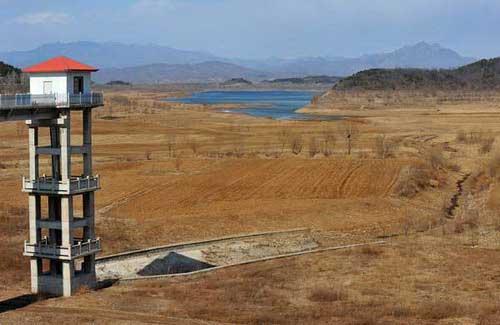
Statistics show that Beijing has consumed 3.5 billion cubic meters of water during the last five years, with 2.5 billion coming from groundwater.
(Ecns.cn)--Beijing has drawn up a blueprint in an effort to fight against severe water scarcity by building up various supply sources, reports the Century Weekly.
The Beijing Development Plan for Key Infrastructures During the Twelfth Five-Year Plan Period, which was published at the end of 2011, strongly emphasizes the importance of the capital's water supply system.
The plan also proposes to preserve local water resources and divert water from other locations, including reservoirs in the nearby provinces of Hebei and Shanxi, as well as areas in the city's outskirts.
Although diverting water from elsewhere is considered a temporary measure, experts say it ensures Beijing's water security in times of urgent need.
About 6,900 hectares of rice fields in the upper reaches of the Miyun reservoir, Beijing's largest, have been used to grow corn and other water-efficient crops since 2007, which has allowed the reservoir to store an additional 50 million cubic meters of water each year, according to data from the municipal water authority in 2011.
Beijing has also been promoting the use of recycled water since 2003, fixing its price at 1 yuan per cubic meter, 0.7 yuan lower than the standard domestic water price.
Households using recycled water have also been exempt from water resource fees and domestic wastewater treatment fees. A total of 680 million cubic meters of recycled water was consumed in 2010, accounting for 19 percent of the city's annual water supply.
The city has also taken advantage of the annual flood season to store water. Thanks to various rainwater collection measures, frequent downpours in Beijing last year filled 16 reservoirs with 35.6 million cubic meters of water, as well as adding 42 million cubic meters of water to the city's lakes and rivers.
Beijing uses water more efficiently than the rest of the country and just as efficiently as many developed countries, Xinhua quoted Wang Hao, head of the water resources department at the China Institute of Water Resources and Hydropower Research.
Pan Anjun, vice head of the Beijing Water Authority (BWA), commented that water supplies for Beijing are the most complicated in the world.
A senior official at the BWA revealed to Century Weekly that two main water resources will be adopted in Beijing during the Twelfth Five-Year Plan period—the South-to-North Water Diversion Project and the water reclamation project, each of which is expected to produce 1 billion cubic meters of water, accounting for at least half of the total supply.
The new projects will consequently release residents from heavily relying on Beijing's groundwater, the over-use of which may make the city vulnerable to pressing hazards like land subsidence.
Statistics show that Beijing has consumed 3.5 billion cubic meters of water during the last five years, with 2.5 billion coming from groundwater.
A People's Daily report in December 2010 suggests that Beijing had used up over 5.6 billion cubic meters of groundwater, equivalent to 2,800 Kunming Lakes, the 2.2-square kilometer central lake at the Summer Palace.
The average water table dropped from 12 meters in 1999 to 24 meters in 2010. By then, 2,650 square kilometers of the total city area had seen land subsidence.
Worse still, official figures suggest Beijing has only 100 cubic meters of water available per person locally, or one-tenth of the United Nations' danger threshold. Yet the number of its permanent residents has been increasing dramatically during the last decade from 13.6 million in 2000 to around 20 million currently.
Even after taking the new water sources into consideration, Beijing will remain a drought city given its increasing population, the Century Weekly points out.
Beijing's two major reservoirs, Miyun and Guanting, have been frequently mired in depletion, with reserves of the latter reduced sharply from over 1 billion cubic meters in the 1950s to less than 100 million cubic meters in 2000.
The municipal government invested 22.15 billion yuan from 2001 to 2005 to tackle the crisis, which produced little effect.
An insider told the Century Weekly that reserves at Guanting Reservoir were below 100 million cubic meters from 2006 to 2009, staying at 96 million, 67 million, 80 million and 22 million cubic meters respectively.
To keep tap water running for its 20 million residents, the government has also advanced various new methods, including seawater desalination and karst water extraction, in its development plan.
A project which desalinates seawater from the Bohai Bay and transports it to Beijing through 230 kilometers of pipes was experimented with in Caofeidian, Hebei Province, in October 2011, according to China Daily.
It is the first desalination project to be designed in China, and may become a main supply source for Beijing within five years. However, residents in the capital have expressed worries about the quality of the desalinated water, as the Bohai Sea suffers from various types of pollution.
Reserves of karst water are less than estimated too, as Beijing has been exploiting the source since as early as 2003, says the Century Weekly.
"A primary investigation suggests that the current annual extraction of karst water has exceeded 250 million cubic meters, roughly half of the total amount allowed each year," said Zhou Rong, an official at the BWA.

Copyright ©1999-2011 Chinanews.com. All rights reserved.
Reproduction in whole or in part without permission is prohibited.